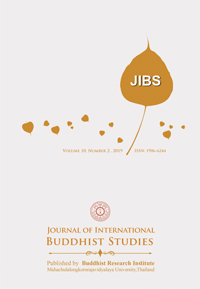A Buddhist Approach to Happiness by Loving-kindness (mettā) For Medical Personnel in New-Normal Age
Keywords:
Happiness, Loving-kindness (mettā), Medical PersonnelAbstract
This article aims to explore a Buddhist approach to happiness by loving-kindness (mettā) for medical personnel in new-normal age. There are a number of obstacles associated with medical personnel, especially with respect to obtaining their approval for routine use from various substantial personal protective equipment shortages, insufficient of the medical personnel, complication of care, and fear of changes. The Buddhist approach to make happiness in order to solve the obstacles of medical personnel that loving-kindness (mettā) is the fundamental principle to bring happiness. Due to mettā goes hand in hand with helpfulness and willingness to forego self-interest in order to promote the welfare and happiness of mankind. Happiness can defined as life-satisfaction, subjective well-being, and good life and denotes a state of mind. Mind developed by loving-kindness (mettā). Mettā is a multi-significant meaning as goodwill, loving-kindness, universal love, a feeling of friendliness and heartfelt, the sincere and genuine wish for the welfare and happiness of all living beings without exception and concern for all living beings, human or non-human, in all situations all over the world. Loving-kindness mettā should be practiced first towards oneself, then other. Therefore, loving-kindness plays most essential role for creating inward happiness for medical personnel in new-normal age.
References
Alipour, A. Pedram, A. Abedi, M. R. & Rostami, Z. (2012). What is Happiness? Interdisciplinary, Journal of Contemporary Research in Business, Vol. 2, No. 12.
Bandyopadhyay, Pranab. (1988). The Voice of Buddha, the Eternal Truth, Calcutta: Punthi pustak.
Bhikkhu, Payutto, P.A. (2007). Vision of the Dhamma, Nakhon Pathom: Wat Nyanavesakavan.
Buheji, M. (2020). The New Normal A New Era Full of Inspiration and Resilience after COVID-19, International Journal of Inspiration & Resilience Economy, Vol. 4, No. 2.
Buheji, M. and Buhaid, N. (2020). “Nursing Human Factor during COVID-19 Pandemic”, International Journal of Nursing Science, Vol. 10, No. 1.
Hopman, J. Allegranzi, B. & Mehtar, S. (2020). Managing COVID-19 in Low and Middle-Income Countries, American Medical Association, Vol. 323, No. 1.
James, Buchan. (2008). Solving Nursing Shortages: A Common Priority, Journal of Clinical Nursing, Vol. 17, No. 24.
Jill, Maben. (2020). Covid-19: Supporting Nurses' Psychological and Mental Health, Journal of Clinical Nursing, Vol. 29, No. 15.
Minkon, Sayardaw. (1985). Brahmavihara Dhamma, Yangon: Myanmar Pitaka Association.
Nārada, Mahathera. (1970). A Manual of Abhidhamma, Yangon: The Buddhasāsana Council.
________. (1995). “A Manual of Buddhism”, Taipei: The Corporate Body of the Buddha Educational Foundation.
________. (1998). The Buddha and His Teachings, Taipei: The Corporate Body of the Buddha Educational Foundation.
________. (1993). The Dhammapada, Pali Text and Translation with stories in Brief and Notes, Taipei: The Corporate Body of the Buddha Educational Foundation.
Niuniu Sun, A. (2020). Qualitative Study on the Psychological Experience of Caregivers of COVID-19 Patients, American Journal of Infection Control AJIC, Vol. 48, No. 6.
O'Boyle, C. Robertson, C. & Secor-Turner, M. (2006). Nurses' Beliefs about Public Health Emergencies: Fear of Abandonment, American Journal of Infection Control, Vol. 34, No. 6.
Phra Medhidhammaporn, (Prayoon Mererk) (1994). Buddhist Morality, Bangkok: Mahachulalongkornrajvidyalaya University.
Ruut, Veenhoven. (2012). Happiness: also Known as ‘Life-Satisfaction’ and ‘Subjective Well-Being’ Handbook of Social Indicators and Quality of Life Research, Dordrecht: Springer Publishers.
________. (2004). World Database of Happiness Continuous Register of Research on Subjective Appreciation of Life, Vol. 24, Dordrecht: Social Indicators Research Series.
Samuel Ayobami, Fasogbon. (2020). Covid-19: The Role of Welfare and Safety of Health Workers in Combating the Outbreak, African Journal of Biology and Medical Research, Volume 3, Issue 2.
Sanu Mahatthanadull, Asst. Prof. Dr. (2019). A Conceptual Model of Bi-Dimensional Development for Happiness Access by Biofeedback Process, A Research Funded by National Research Council of Thailand (NRCT) Fiscal Year 2019, Buddhist Research Institute: Mahachulalongkornrajavidyalaya University.
________. (2020). Concepts and Principles of Buddhism, Teaching Document, Buddhist Studies Programme, Ayutthaya: Mahachulalongkornrajavidyalaya University Press.
________. (2019). Theravāda Buddhist Practice and the Access of Happiness, Research Report, The 2nd International Academic Forum in Theravāda and Mahāyāna Buddhism.
Sri Dhammananda, K. Dr. (2002). What Buddhist Believe, Kuala Lumpur: Buddhist Missionary Society.







